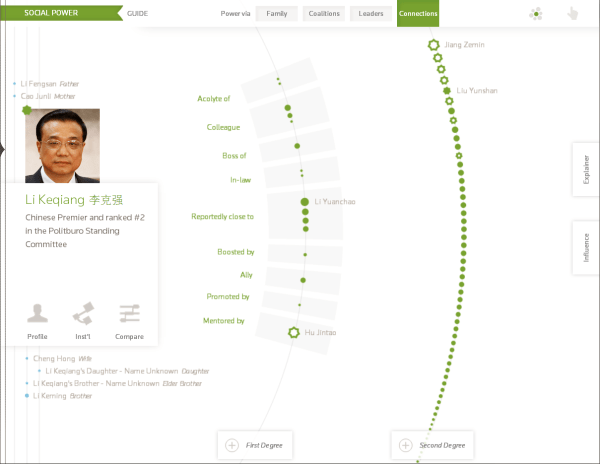Exploring China’s elite power structure
Reuters recently launched Connected China, a Reuters* News site that tracks and visualizes the people, organizations and relationships that form China’s elite power structure. Network visualization helps understand China’s elite power structure.
In China power is about networks
The website aims to provide a deep look into the social and professional networks of China’s leaders, highlighting the interpersonal relationships that drive business, move markets and shape the political landscape in the world’s most populous nation. It’s a very impressive project that brings together visualization tools and hard data including :
- Tens of thousands of entities – people, organizations, events
- More than 30,000 relationships
- 1.5 million words (equivalent to more than 20 non-fiction books!)
China is notoriously hard to understand. The Connected China project is successful in uncovering relationships within Chinese elite (family, mentorship, rivalry, alliances) and communicating them in an interactive way. The key insight that comes out of this project, seems to be that networks are key to understand how decisions are shaped in China.
Take for example Li Keqiang, the current Premier of the People’s Republic of China and party secretary of the State Council.

Looking only at his direct connections, we can see that he is an acolyte (of Gong Xiangrui or Li Yining), has family ties (with Liu Yiqing and Cheng Jinrui), allies and friends (like Chen Quanguo or Li Yuanchao) and a mentor, Hu Jintao. Among these people are the former General Secretary of the Communist Party, the Chief of Tibet Autonomous Region, the Vice President of the People’s Republic of China. Li Keqiang’s decision-making is influenced by these people and he can rely on them to reach his objectives. Chinese actually have a concept to talk about that : “Guanxi”. According to Wikipedia :
« Guanxi describes a personal connection between two people in which one is able to prevail upon another to perform a favor or service, or be prevailed upon. Guanxi can also be used to describe a network of contacts, which an individual can call upon when something needs to be done, and through which he or she can exert influence on behalf of another. »
Using network visualization, Connected China is able to give us a better glimpse within Chinese elite. It shows with greater details the relationships important individuals are influenced by. It’s richer than the traditional descriptions that paint broad cliques and leave out the power dynamic. See for example the list of power families as described by the Financial Times.
A data journalism approach to investigation
What’s great about Reuter’s project is the focus on hard data. All the information about the connection are actually entered and sourced by journalists. What’s even better is that it seems the project will be ongoing. Data will be continuously entered. By design, this website, will be part of the way Reuter covers China. It removes a traditional problem with news investigation : the propensity to create one-off reports that slowly get outdated.
Graph visualization is a great way to explore and visualize real life networks. It makes it possible to understand how things are connected and extract valuable insights out of a complicated network. We can only hope to see more big data projects run by news organizations!
* Connected China is not affiliated not endorsed by Linkurious. Reuters and Reuters News are registered trademarks of Thomson Reuters Corp.
A spotlight on graph technology directly in your inbox.